Kosa-dori (or Ai-hanmi)
DAI SANKYO
(Sokumen)
Demonstrated and explained by Kanetsuka Sensei
|
|

Photos and text: Peter Megann
Graphics and typesetting: Graham and Laura Jones
Uke: Richard Martin
|
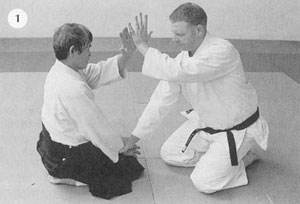 Photo 1: In katate-dori or kosa-dori. at the moment that your partner takes your wrist you should assume correct posture and correct ma-ai, which means having good contact with your partner. From this position you can make the Technique omote, ura or sokumen. The point is whether you can lead your partner. Here Uke has taken Tori's right wrist with his right hand (this is why the situation is called kosa-dori: 'cross-holding'), either pushing or pulling. At this moment he can strike Tori's head with his other hand (or Tori can initiate a strike). Of course, Tori's wrist could be grabbed at chudan level. The situation in this photo represents the most difficult one. It is impossible for Tori to cut straight up with his right arm since Uhe's force is concentrated on his right wrist. You should open your hand and splay your fingers.
Photo 1: In katate-dori or kosa-dori. at the moment that your partner takes your wrist you should assume correct posture and correct ma-ai, which means having good contact with your partner. From this position you can make the Technique omote, ura or sokumen. The point is whether you can lead your partner. Here Uke has taken Tori's right wrist with his right hand (this is why the situation is called kosa-dori: 'cross-holding'), either pushing or pulling. At this moment he can strike Tori's head with his other hand (or Tori can initiate a strike). Of course, Tori's wrist could be grabbed at chudan level. The situation in this photo represents the most difficult one. It is impossible for Tori to cut straight up with his right arm since Uhe's force is concentrated on his right wrist. You should open your hand and splay your fingers.
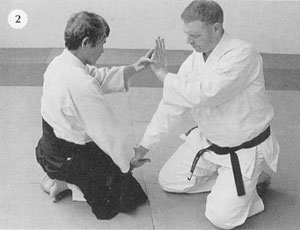 Photo 2: Tori comes up onto his toes, and sliding his knee to the side he moves his whole body to his left (without trying to move his right wrist independently). Notice how his hand has started to turn with the thumb pointing downwards and the palm towards the outside. Notice that the palm is open, the finger-tips are pointing inward, and Tori's ring finger is sticking to Uke's wrist. Tori's whole arm is beginning to stretch outwards in the shape of an are, from the shoulder to the band, the elbow coming up and expanding (as it does when making za-rei). His hand begins to make a large circular movement to the left (this is a little like The movement of the arms when we do breast-stroke in swimming), the finger-Lips pointing inwards.
Photo 2: Tori comes up onto his toes, and sliding his knee to the side he moves his whole body to his left (without trying to move his right wrist independently). Notice how his hand has started to turn with the thumb pointing downwards and the palm towards the outside. Notice that the palm is open, the finger-tips are pointing inward, and Tori's ring finger is sticking to Uke's wrist. Tori's whole arm is beginning to stretch outwards in the shape of an are, from the shoulder to the band, the elbow coming up and expanding (as it does when making za-rei). His hand begins to make a large circular movement to the left (this is a little like The movement of the arms when we do breast-stroke in swimming), the finger-Lips pointing inwards.
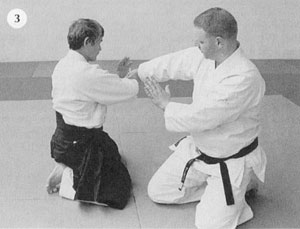 Photo 3: As Tori swings his arm up, the circular movement of his hand continues upwards to the height of his eyes, the thumb pointing towards his nose, his whole arm extending. During this whole movement his left hand stays in line with his body (not moving left or right).
Photo 3: As Tori swings his arm up, the circular movement of his hand continues upwards to the height of his eyes, the thumb pointing towards his nose, his whole arm extending. During this whole movement his left hand stays in line with his body (not moving left or right).
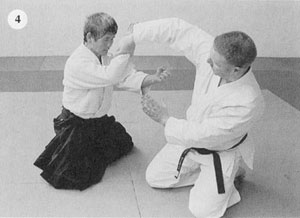 Photo 4: Now Tori slides his right knee slightly to (he right, so turning his body to the right. His position is now essentially that of sokumen ('to the side'). His left hand is protecting him and at this point his arms are crossed- At this moment the contact is identical with that of shomen-uchi ikkyo. You should not try to hold with your right hand, just keep contact with your te-gatana ('hand-blade'), leading your partner's arm, not pushing it. Making atemi with his left hand means that Tori is concentrating on his partner's centre.
Photo 4: Now Tori slides his right knee slightly to (he right, so turning his body to the right. His position is now essentially that of sokumen ('to the side'). His left hand is protecting him and at this point his arms are crossed- At this moment the contact is identical with that of shomen-uchi ikkyo. You should not try to hold with your right hand, just keep contact with your te-gatana ('hand-blade'), leading your partner's arm, not pushing it. Making atemi with his left hand means that Tori is concentrating on his partner's centre.
 Photo 5: Tori's right hand has continued in an unbroken circle and has come back to the starting point of Photos 1 & 2. To do this your shoulder and body must be very relaxed. In this way you avoid your partner's attack and control him without any struggle. The point is that you should be leading, not forcing your partner. So your movement should be one of expansion and extension: not pushing; rather, swinging your arm up and down. Your whole body is turning to the right (not twisting), exactly as in suwari-waza kokyu-ho. Always keep some space between you and Up to this point the movements are identical with those of ikkyo.
Photo 5: Tori's right hand has continued in an unbroken circle and has come back to the starting point of Photos 1 & 2. To do this your shoulder and body must be very relaxed. In this way you avoid your partner's attack and control him without any struggle. The point is that you should be leading, not forcing your partner. So your movement should be one of expansion and extension: not pushing; rather, swinging your arm up and down. Your whole body is turning to the right (not twisting), exactly as in suwari-waza kokyu-ho. Always keep some space between you and Up to this point the movements are identical with those of ikkyo.
Photos 6 & 7: While controlling Uke with his left hand just above Uke's elbow, stretching his.arm from his shoulder. Tori slides his right hand to hold Uke's fingers with a sankyo grip; but there is no need to hold tightly. Note that you should not be pushing or gripping: just controlling. Your stream of energy should be flowing from your toes, through your knees up to your shoulders, then down your arms to your hands, and crossing as shown in Photo 6. Keeping his back straight and moving his centre forwards Tori slides his left knee slightly towards Uke's armpit and bead. The action on Uke's arm is like thrusting with a spear. But don't move too much at this point: just create kime (impact).
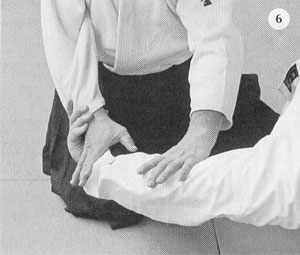
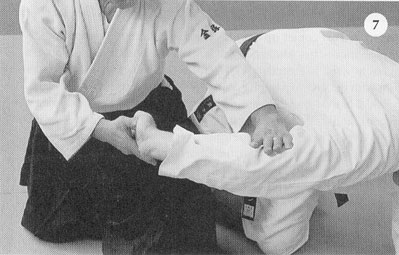
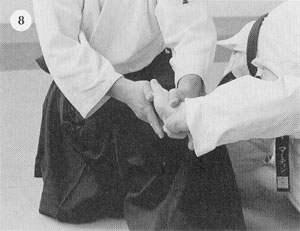 Photo 8: Tori slides his left hand to his right hand and takes Uke's hand, controlling it with a sankyo grip, screwing the hand inwards. Again, there is no need for a light grip and you should not push.
Photo 8: Tori slides his left hand to his right hand and takes Uke's hand, controlling it with a sankyo grip, screwing the hand inwards. Again, there is no need for a light grip and you should not push.
Photos 9 & 10: Tori maintains the screwing action on Uke's wrist and elbow (the action is like that of a coil), keeping his left hand in the same point in front of him as his body rises and he applies his centre of gravity upon Uke's lower arm. Bringing up his right knee he makes irimi around Uke's wrist and places his right hand just above Uke's elbow.
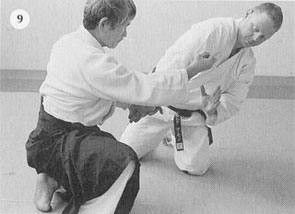
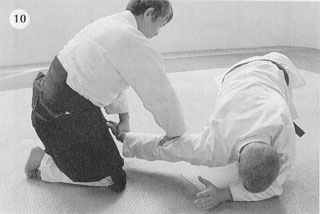
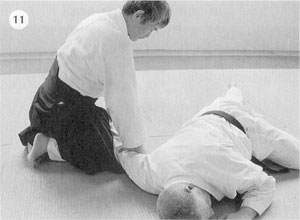 Photo 11: Tori pivots on his right knee (tenkan) and finishes in kiza in a position which is just like the finishing position of ikkyo, but reversed, as it where.
Photo 11: Tori pivots on his right knee (tenkan) and finishes in kiza in a position which is just like the finishing position of ikkyo, but reversed, as it where.
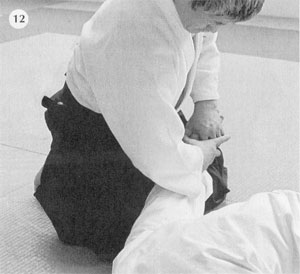 Photo 12: After sliding his right knee slightly to the outside of Uke's shoulder, Tori pivots round to bring his left knee to the other side of Uke's shoulder. (Note that he is sitting in kiza). He slides his right hand up to (Uke's hand to take over the sankyo grip from his left hand, not giving him the slightest chance to escape. Don't be too close to your partner at this stage. You need to leave some space to manipulate his arm and allow his joints to adjust, thus avoiding injury. You notice that Tori's left knee has not yet come very close to Uke's body.
Photo 12: After sliding his right knee slightly to the outside of Uke's shoulder, Tori pivots round to bring his left knee to the other side of Uke's shoulder. (Note that he is sitting in kiza). He slides his right hand up to (Uke's hand to take over the sankyo grip from his left hand, not giving him the slightest chance to escape. Don't be too close to your partner at this stage. You need to leave some space to manipulate his arm and allow his joints to adjust, thus avoiding injury. You notice that Tori's left knee has not yet come very close to Uke's body.
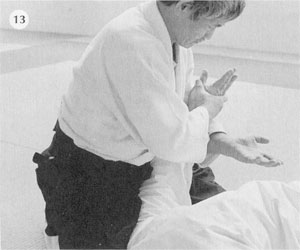 Photos 13-15: Tori has slid his right knee nearer to his partner's shoulder and is placing Uke's hand onto his left
shoulder and wrapping his left hand, palm upwards, round Uke's arm. It's not so much a matter of clamping your partner's arm to your body as of hugging it. Keep your centre of gravity low (don't rise up off your heels) and keep your back straight. Bear downwards on your partner's arm at the same time as you rotate your upper body in a circular path around his right shoulder-blade. This movement should be made without jerking, slowly and with control. As soon as your partner taps, release the pressure steadily.
Photos 13-15: Tori has slid his right knee nearer to his partner's shoulder and is placing Uke's hand onto his left
shoulder and wrapping his left hand, palm upwards, round Uke's arm. It's not so much a matter of clamping your partner's arm to your body as of hugging it. Keep your centre of gravity low (don't rise up off your heels) and keep your back straight. Bear downwards on your partner's arm at the same time as you rotate your upper body in a circular path around his right shoulder-blade. This movement should be made without jerking, slowly and with control. As soon as your partner taps, release the pressure steadily.
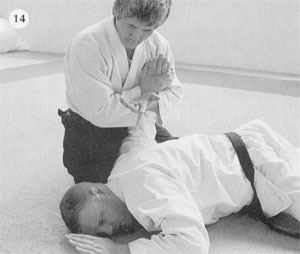
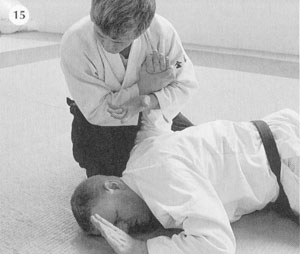
Photo 16-21: The first part of kosa-dori dai sankyo in tachi-waza.
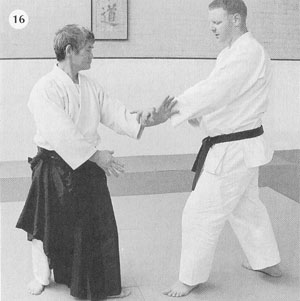
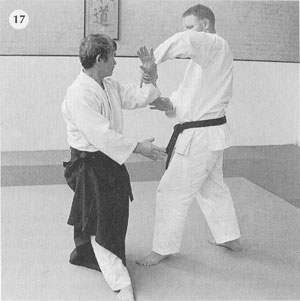
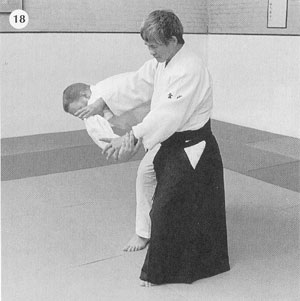

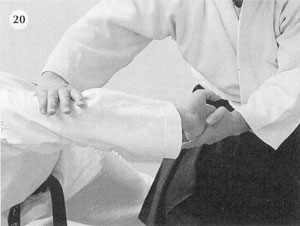
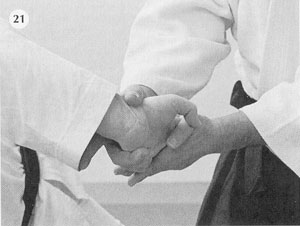

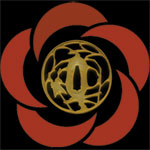
 Photo 1: In katate-dori or kosa-dori. at the moment that your partner takes your wrist you should assume correct posture and correct ma-ai, which means having good contact with your partner. From this position you can make the Technique omote, ura or sokumen. The point is whether you can lead your partner. Here Uke has taken Tori's right wrist with his right hand (this is why the situation is called kosa-dori: 'cross-holding'), either pushing or pulling. At this moment he can strike Tori's head with his other hand (or Tori can initiate a strike). Of course, Tori's wrist could be grabbed at chudan level. The situation in this photo represents the most difficult one. It is impossible for Tori to cut straight up with his right arm since Uhe's force is concentrated on his right wrist. You should open your hand and splay your fingers.
Photo 1: In katate-dori or kosa-dori. at the moment that your partner takes your wrist you should assume correct posture and correct ma-ai, which means having good contact with your partner. From this position you can make the Technique omote, ura or sokumen. The point is whether you can lead your partner. Here Uke has taken Tori's right wrist with his right hand (this is why the situation is called kosa-dori: 'cross-holding'), either pushing or pulling. At this moment he can strike Tori's head with his other hand (or Tori can initiate a strike). Of course, Tori's wrist could be grabbed at chudan level. The situation in this photo represents the most difficult one. It is impossible for Tori to cut straight up with his right arm since Uhe's force is concentrated on his right wrist. You should open your hand and splay your fingers. Photo 2: Tori comes up onto his toes, and sliding his knee to the side he moves his whole body to his left (without trying to move his right wrist independently). Notice how his hand has started to turn with the thumb pointing downwards and the palm towards the outside. Notice that the palm is open, the finger-tips are pointing inward, and Tori's ring finger is sticking to Uke's wrist. Tori's whole arm is beginning to stretch outwards in the shape of an are, from the shoulder to the band, the elbow coming up and expanding (as it does when making za-rei). His hand begins to make a large circular movement to the left (this is a little like The movement of the arms when we do breast-stroke in swimming), the finger-Lips pointing inwards.
Photo 2: Tori comes up onto his toes, and sliding his knee to the side he moves his whole body to his left (without trying to move his right wrist independently). Notice how his hand has started to turn with the thumb pointing downwards and the palm towards the outside. Notice that the palm is open, the finger-tips are pointing inward, and Tori's ring finger is sticking to Uke's wrist. Tori's whole arm is beginning to stretch outwards in the shape of an are, from the shoulder to the band, the elbow coming up and expanding (as it does when making za-rei). His hand begins to make a large circular movement to the left (this is a little like The movement of the arms when we do breast-stroke in swimming), the finger-Lips pointing inwards. Photo 3: As Tori swings his arm up, the circular movement of his hand continues upwards to the height of his eyes, the thumb pointing towards his nose, his whole arm extending. During this whole movement his left hand stays in line with his body (not moving left or right).
Photo 3: As Tori swings his arm up, the circular movement of his hand continues upwards to the height of his eyes, the thumb pointing towards his nose, his whole arm extending. During this whole movement his left hand stays in line with his body (not moving left or right). Photo 4: Now Tori slides his right knee slightly to (he right, so turning his body to the right. His position is now essentially that of sokumen ('to the side'). His left hand is protecting him and at this point his arms are crossed- At this moment the contact is identical with that of shomen-uchi ikkyo. You should not try to hold with your right hand, just keep contact with your te-gatana ('hand-blade'), leading your partner's arm, not pushing it. Making atemi with his left hand means that Tori is concentrating on his partner's centre.
Photo 4: Now Tori slides his right knee slightly to (he right, so turning his body to the right. His position is now essentially that of sokumen ('to the side'). His left hand is protecting him and at this point his arms are crossed- At this moment the contact is identical with that of shomen-uchi ikkyo. You should not try to hold with your right hand, just keep contact with your te-gatana ('hand-blade'), leading your partner's arm, not pushing it. Making atemi with his left hand means that Tori is concentrating on his partner's centre. Photo 5: Tori's right hand has continued in an unbroken circle and has come back to the starting point of Photos 1 & 2. To do this your shoulder and body must be very relaxed. In this way you avoid your partner's attack and control him without any struggle. The point is that you should be leading, not forcing your partner. So your movement should be one of expansion and extension: not pushing; rather, swinging your arm up and down. Your whole body is turning to the right (not twisting), exactly as in suwari-waza kokyu-ho. Always keep some space between you and Up to this point the movements are identical with those of ikkyo.
Photo 5: Tori's right hand has continued in an unbroken circle and has come back to the starting point of Photos 1 & 2. To do this your shoulder and body must be very relaxed. In this way you avoid your partner's attack and control him without any struggle. The point is that you should be leading, not forcing your partner. So your movement should be one of expansion and extension: not pushing; rather, swinging your arm up and down. Your whole body is turning to the right (not twisting), exactly as in suwari-waza kokyu-ho. Always keep some space between you and Up to this point the movements are identical with those of ikkyo.

 Photo 8: Tori slides his left hand to his right hand and takes Uke's hand, controlling it with a sankyo grip, screwing the hand inwards. Again, there is no need for a light grip and you should not push.
Photo 8: Tori slides his left hand to his right hand and takes Uke's hand, controlling it with a sankyo grip, screwing the hand inwards. Again, there is no need for a light grip and you should not push.

 Photo 11: Tori pivots on his right knee (tenkan) and finishes in kiza in a position which is just like the finishing position of ikkyo, but reversed, as it where.
Photo 11: Tori pivots on his right knee (tenkan) and finishes in kiza in a position which is just like the finishing position of ikkyo, but reversed, as it where. Photo 12: After sliding his right knee slightly to the outside of Uke's shoulder, Tori pivots round to bring his left knee to the other side of Uke's shoulder. (Note that he is sitting in kiza). He slides his right hand up to (Uke's hand to take over the sankyo grip from his left hand, not giving him the slightest chance to escape. Don't be too close to your partner at this stage. You need to leave some space to manipulate his arm and allow his joints to adjust, thus avoiding injury. You notice that Tori's left knee has not yet come very close to Uke's body.
Photo 12: After sliding his right knee slightly to the outside of Uke's shoulder, Tori pivots round to bring his left knee to the other side of Uke's shoulder. (Note that he is sitting in kiza). He slides his right hand up to (Uke's hand to take over the sankyo grip from his left hand, not giving him the slightest chance to escape. Don't be too close to your partner at this stage. You need to leave some space to manipulate his arm and allow his joints to adjust, thus avoiding injury. You notice that Tori's left knee has not yet come very close to Uke's body.
 Photos 13-15: Tori has slid his right knee nearer to his partner's shoulder and is placing Uke's hand onto his left
shoulder and wrapping his left hand, palm upwards, round Uke's arm. It's not so much a matter of clamping your partner's arm to your body as of hugging it. Keep your centre of gravity low (don't rise up off your heels) and keep your back straight. Bear downwards on your partner's arm at the same time as you rotate your upper body in a circular path around his right shoulder-blade. This movement should be made without jerking, slowly and with control. As soon as your partner taps, release the pressure steadily.
Photos 13-15: Tori has slid his right knee nearer to his partner's shoulder and is placing Uke's hand onto his left
shoulder and wrapping his left hand, palm upwards, round Uke's arm. It's not so much a matter of clamping your partner's arm to your body as of hugging it. Keep your centre of gravity low (don't rise up off your heels) and keep your back straight. Bear downwards on your partner's arm at the same time as you rotate your upper body in a circular path around his right shoulder-blade. This movement should be made without jerking, slowly and with control. As soon as your partner taps, release the pressure steadily.






